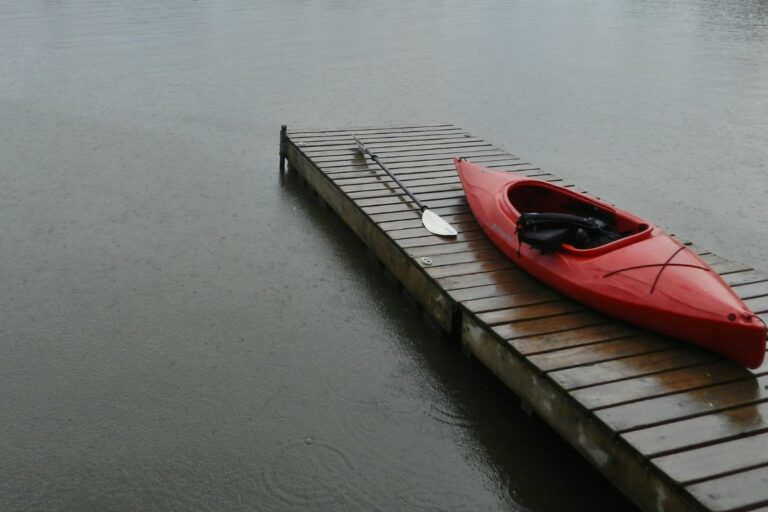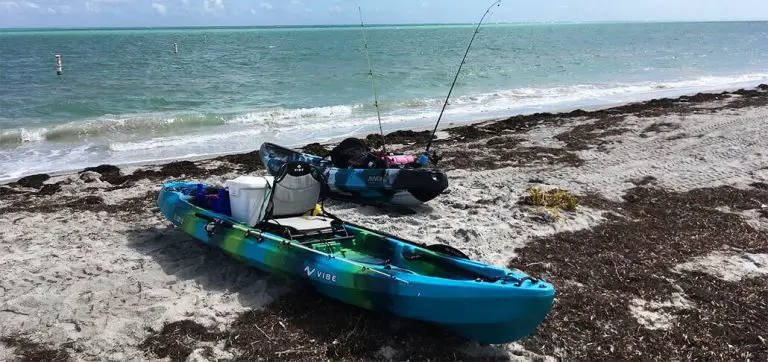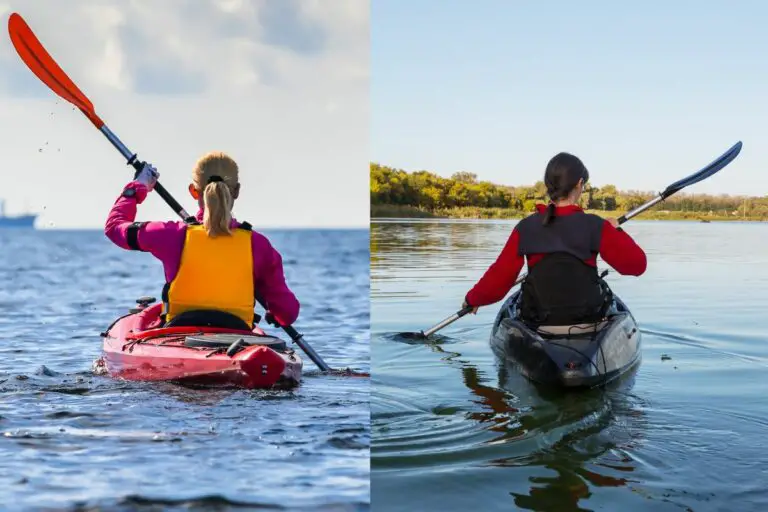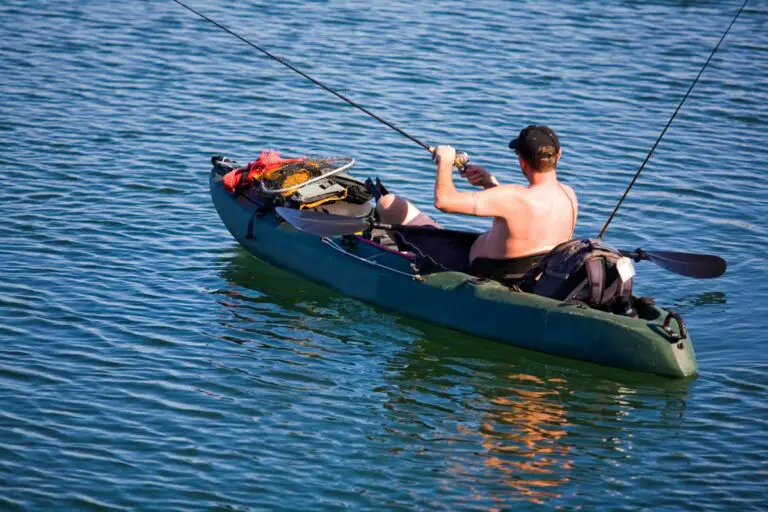Do Sharks Attack Kayaks? Why You Should Be More Careful
The possibility of getting attacked by a shark while kayaking isn’t really that high; however, it’s not completely impossible. Fortunately, there is a lot of information that can help kayakers protect themselves.
So, do sharks attack kayaks? Sharks do attack kayaks, although these attacks are considered very rare. They mostly happen because sharks mistake the boat for prey. Sharks are not trying actually to attack or feed on the kayaker; they’re mainly trying to investigate if there’s something they can potentially feed on.
Keep reading to learn the truth about shark attacks on kayaks and useful tips to help you avoid shark attacks and stay safe while kayaking.
Table of Contents
Do Sharks Attack Kayaks – A Dive into the numbers.
Most shark attacks on kayaks are considered more as encounters rather than attacks since sharks do not actually attack the kayaker, and there are rarely any injuries.
An encounter will happen because the shark likely confused the kayak and the humans on board with prey. So, the shark will bump the boat to investigate and try to determine if it is really prey or something that is worth eating.
However, this does not mean sharks are not dangerous. There are real shark attacks that do really happen, and kayakers should always take safety measures.
In most cases, when a shark attack on a kayak happens, it’s because the shark mistakes the kayak for a seal or sea lion.
A shark’s natural diet is marine life, particularly saltwater marine life. Great White Sharks will feed on young fish and are known to feed on other sharks. As the sharks grow in size, they tend to prefer sea lions and seals more.
Sharks do not really crave human flesh or blood. They are much more attracted to the taste of meat from saltwater marine life than the meat from land-based animals, which includes humans.
Did you know that out of the 375 species of sharks, only 12 types are categorized as dangerous, while only four species are known to have been involved in human attacks?
Let’s take a closer look at some interesting facts about those four species:
| Species | Size | Location | Danger Level | Facts |
|---|---|---|---|---|
| Great White Shark | It’s 18 feet long and weighs 1500-2500 pounds | It’s found in mild waters worldwide, usually close to the shore. | Very High | These sharks are large, aggressive, and proficient killers. They’re also curious and like to get a taste of anything they come across. About one-third of the total annual shark attacks are credited to this species. They can throw kayakers from their boat with almost no effort. |
| Tiger Shark | It spans 20-25 feet and weighs 850-1500 pounds | It’s found in mild and tropical climates worldwide. | High | They’re aggressive and have a great sense of smell. They’re also famous for their appetite to eat anything from living creatures to wood, rubber, and more. Their population is very low as they’re hunted for their flesh, skin, and other body parts. |
| Bull Shark | It’s over 11 feet and weighs about 200 pounds | It’s found in tropical, subtropical, and mild climates. It can survive in freshwater. | High | Although they’re small, they’re still very aggressive. |
| Shortfin Mako Shark | It’s about 10 feet and weighs 130-200 pounds | It’s found in mild and tropical climates worldwide. | Low | They’re often mistaken for small great white sharks. They’re not as aggressive, and they do not attack unless provoked. |
If you cannot visualize what a shark attack on a kayak might look like, check out this video showing how a bull shark attacks a kayak.
How Many Kayakers Have Been Killed by Sharks?
Now that you know more information about the types of sharks that can be dangerous, let’s take a look at some statistical facts related to shark attacks:
- Only 22% out of all recorded shark attacks worldwide resulted in a fatality. Kayakers make up only 0.35% of the recorded fatalities.
- Between 1779 and 2020 – Only 59 out of 6,522 recorded shark incidents involved a kayak. Only 5 incidents, or 10% out of those 59 incidents, were fatal.
- In 2019 there were only 64 confirmed unprovoked shark attacks worldwide, with only 2 of them being fatal.
- The United States has more shark attacks than any other country, with 36% of all recorded shark attacks. Australia comes second with 21.42%, and South Africa comes third with 9.04%.
- While it may seem that the number of attacks has been increasing over the years, the percentage actually hasn’t. In fact, sharks have more to fear from humans than we have to fear from them. For every human killed by a shark, about 2,000,000 sharks are killed by humans.
Here is a quick visual that shows just how rare it is for sharks to attack kayaks
Too confusing? Let’s look at it from another perspective:
- From 2001 to 2010, there were 364 fatalities resulting from dog attacks. At the same time span, there were only 11 victims of fatal shark attacks.
- From 1959 to 2010, there were 1,970 fatalities resulting from being struck by lightning, while there were only 26 victims of fatal shark attacks.
So, what are really the odds of being a victim of a fatal shark attack?
The odds of being the victim of a fatal shark attack are 1 in 3,748,067. On the other hand, the odds of being fatally struck by lightning are 1 in 79,746, and the odds of being involved in a fatal car crash are 1 in 84.
Yes, you are about 44,000 times more likely to be involved in a fatal car crash than you are to be the victim of a fatal shark attack.
Can Kayaks Actually Attract Sharks?

The media has perhaps deceived many people into thinking that kayaks attract sharks like magnets. However, sharks are more likely to pass by a kayak totally unprovoked
Then why do these shark attacks happen every once in a while? As mentioned before, sharks are curious creatures. They like to investigate unfamiliar objects and often confuse them with prey.
Almost all of these attacks are a result of this confusion. It’s very rare that something about the kayak actually attracts the shark, which takes us to the next question.
What Color Kayaks Attract Sharks?
There is no specific color or pattern that can attract or deter sharks. Sharks are known to have poor vision, and they rely more on their other senses, like smell and hearing. When sharks use their eyes to identify their prey, they will only see shadows and motions, not colors. So, the actual color of the kayak doesn’t make a difference.
Are There Shark Proof Kayaks?
There are no kayaks specifically designed to be shark-proof. However, it’s recommended to go for kayaks that are made from a durable material like thermoform if you’re going to be paddling near shark territory. It’s also best to avoid inflatable kayaks as they are the most prone to get damaged from the shark’s teeth.
For Thermoform kayaks, the most recommended is The Quest 518 Superlite because they’re harder and more resistant to scratches. They’re also very light in weight.
Contrary to popular belief, painting your kayak a certain color will not help you avoid a shark’s attack.
How to Avoid Sharks While Kayaking?

To avoid sharks while kayaking, you need to stay away from territories where sharks live. When kayaking close to shore, stay away from river mouths.
To avoid being mistaken for prey, stay away from large groups of fish, seals, or sea lions. Try to avoid any blood in the water and slicks from fishing boats. Also, avoid being in the water at dusk and dawn as sharks are the prime hunting times.
There are some products you can purchase that can repel sharks. While they are not proven to be 100% effective, they can provide you with some peace of mind. There are different types of shark repellent, including electrical emitters, magnetic blockers, acoustic-based repellents, and simple spray repellents.
Let’s break down how each type works in more detail.
Types of Shark Repellents
Electric Shark Repellents
Electric Shark repellents use electrical signals in the water to interfere with sharks’ sensory input. So, if a shark enters the radius of these electronic devices, it will experience a sensory overload which will likely cause them to go in a different direction.
Magnetic Shark Repellents
Magnetic shark repellents don’t utilize electrodes. Instead, they utilize a magnetic field via a wrist or ankle band that you can easily strap on with your typical watch band.
I have the Sharkbanz 2 magnetic shark repellent, but I have not yet encountered sharks to test it out, and I’m not actually planning on going anywhere near sharks soon to test it out, but it has hundreds of positive reviews from people who really seem to like it, so I think you should check it out on Amazon or click on the image below.

Acoustic Shark Repellents
Acoustic shark deterrents are small wearable devices that send out a combination of Ocra calls and various sounds to repel sharks. By imitating the sound of a killer whale or similar species, it can scare away passing sharks.
Spray Repellents
Some scientific evidence suggests that the smell of other dead sharks repels sharks. Spray repellents basically carry the essence of dead sharks; however, the effects of the spray are only temporary and will likely dissipate after spending more time in the water.
What Should You Do If You See a Shark While Kayaking?
If you do see a shark, the most important thing is to stay calm and try not to paddle away frantically. Splashing your paddle could make you look more like an injured seal, attracting the shark’s attention.
If the shark got more aggressive or tried to get closer to your kayak, try to use your paddle as a weapon to scare it off by giving it a hard tap on the snout but be careful as you could make it angrier.
It’s very crucial to try to stay in your kayak, as it is the relatively safest place for you during a shark attack. In some cases, the sharks can get provoked and angry enough that they can easily knock you out of the kayak and into the water.
What to Do If You Got Knocked Out of Your Kayak?
If the shark did manage to knock you out of your kayak, the best thing you can do is to try to get back into it again quickly. Re-entering your kayak in deep water can be difficult, but it can be a lot easier with practice. So, try to practice when it is not an emergency situation so you can get better at it.
Once you have managed to get back onto your kayak, try to paddle calmly toward the shore. Make sure to keep an eye on the shark to see if it’s following you or if it’s getting closer. It’s a good idea to paddle backward to help you keep your eyes on the shark better.
In case the kayak drifts out of your reach while you are in the water, if it’s possible, try to swim to the shore calmly. However, swimming back should only be a last resort; you’re still far safer in your kayak than in the water. If other kayakers are nearby, try to get yourself on their boat and out of the water as quickly as possible.
Looking for something more visual? Here is a quick video that shows you exactly how to do it.
How to Stay Safe While Kayaking?
As rare as shark attacks are, it is still important to take precautions to remain safe when kayaking in general.
Here are some useful tips that will be helpful to you:
13 Basic Kayaking Safety Tips You Must Know

- Keep an eye on weather conditions and water temperature.
Be prepared for any changes in weather and the possibility of a capsize. Be careful of off-shore winds as they can make it difficult to return to shore.
- Keep an eye on shark reports.
Areas with frequent shark sightings often have a monitoring system in place for large sharks. When a shark is sighted, the beaches will be temporarily closed, and access to the water will be restricted.
- Invest in the right clothing.
Try to dress according to the weather. If you’re paddling in cold water, you could wear a wet or dry suit to keep you warm. If you’re paddling in warm weather, you could wear a long-sleeved shirt that can provide more protection from the sun.
Try to stay away from materials that aren’t water resistant, especially cotton, as it retains water and reduces your body temperature. Jeans are also very inappropriate to kayak in as they can constrict your movement.
- Always carry a first aid kit
A standard first aid kit is a must-have on any trip. They’re typically equipped for minor injuries or sunburns.
Consider learning some basic first aid procedures like treating cuts, treating hypothermia, and performing CPR.
- Always follow the local boating rules of the area you are in.
If you’re paddling in a new area, make sure to do your research and learn all its rules and regulations.
Check with the locals regarding currents, shoreline conditions, and weather patterns.
You should also know how far you are allowed to kayak in a certain area, and if you are going kayaking in the sea or ocean, it’s never a good idea to get too far away from shore.
- Make sure you’re in peak physical condition.
Never go kayaking if you’re drinking alcohol or taking any drugs (prescription or non-prescription)
Make sure to stay hydrated and always bring enough water and food.
- Make sure your kayak is also in peak condition.
Make sure to double-check your kayak and equipment for any damage before you go paddling.
Learn everything you need to know about the features of your kayak and try not to exceed its weight capacity.
- Familiarize yourself with paddling styles.
Seek qualified instruction to make yourself familiar with paddling styles.
Practice your paddling strokes before going out in the water. There are four main strokes that you need to learn; the forward stroke, reverse stroke, sweep stroke and draw stroke.
- Practice Kayak Re-Entry
Practice re-entering your kayak from the water in case of any incident that could lead to you getting knocked off your kayak
Re-entering a sit-on-top kayak can be a lot easier than re-entering a sit-inside kayak.
If you still haven’t mastered re-entering your kayak from the water, then it is best to stay close to shore so you can swim back if you need to.
- Wear a personal floatation device.
Coast Guard regulations always require that all kayaks should have a lifejacket on board.
Wearing a lifejacket will help keep your head above water and also add more insulation to your body to keep you warmer in cold water.
There are kinds of PFDs designed specifically for paddlers. Get one that fits you well, and make sure always to wear it while you’re paddling.
- Inform someone of your paddle plan
Make sure someone knows where you are going, the route you’ll be taking, what you will be doing, how long you expect to be gone, and how many people are in your party. Then make sure you stick to your plan.
- Do not go kayaking alone
There should always be someone with you in case of an accident, no matter your experience level.
- Stay away from feeding zones.
Most shark attacks take place within the first 100 feet from shore. Littoral zones are known as the preferred feeding areas for a variety of fish. It’s also where seals tend to be the most vulnerable.
Following these tips will definitely guarantee you a safer and overall better experience next time you go kayaking.
For more safety tips while kayaking, check out my guide on Kayaking near alligators, as I also go in-depth with how to stay safe while Kayaking.
What Kind of Safety Gear Do You Need When Kayaking?
When you’re heading out on a kayaking trip, you need to make sure you have the right kind of equipment.
Here’s a list of the essential gear that will help to keep you safe:
Personal Flotation Device
When buying a PFD, it’s recommended to go for the ones specifically designed for kayaking. This will offer more comfort and won’t obstruct your paddling. Try your PFD on to make sure it fits right and also doesn’t restrict your movement.
Air Horn/Whistle/Flares
Always bring some method of attracting attention to you in case of an emergency. You can attach it to your PFD.
Air horns and whistles are more useful on rivers and lakes, while flares are better in low-light conditions. Keep in mind that one blast is for attention, while three blasts mean “help.” If you can’t remember how many blasts, just keep going until a rescuer arrives.
Communication Device
You can bring a cellphone in a waterproof case if there’s good cell coverage; otherwise, you might need to invest in a VHF radio.
Bilge Pump/Sponge
This will help you expel water out of the kayak’s interior quickly at a quick rate in the event of a capsize. They can be easily stored since most kayaks don’t have big storage space.
Spare Paddle
Having one spare paddle per paddler is recommended. If you’re going on a trip with a group, they can share one or two spares.
Paddle Float
A paddle float is an inflatable device that you attach to the blade of your paddle. This device requires some training before you can use it.
When it’s inflated, the paddle floats can serve as an emergency flotation device which allows you to stabilize your kayak when you’re trying to re-enter it from the water.
Rope/Towline
A rope is always an essential part of any safety equipment. It has a lot of uses when it comes to kayaking, like securing a kayak to a bank, towing a kayak back to shore, or even tying yourself to a capsized kayak while you wait for rescue.
You can keep your rope in a specialized rope bag that will keep it dry and also allow it to be stored neatly and safely.
Dry-Bag
Dry bags will prevent your essential equipment from getting wet by trapping a small amount of air in them. It will also prevent your equipment from sinking. You can use your dry bag to store spare dry clothes, sunscreen, water, and your first-aid kit.
Headlamp/Torchlight
It’s good to have one just in case it gets dark and you’re still out on the water
Is Kayaking in The Ocean Dangerous?
Kayaking in the ocean can be dangerous if you’re inexperienced or not well prepared. Oceans are unpredictable, and many risks come with being in open water, such as capsizing because of tidal waves or currents, which could lead to getting trapped under your kayak or drowning. Maintaining a sense of direction is also hard, so you could easily get lost.
Choosing the right kayak can make a huge difference, so make sure to check out these excellent ocean fishing kayaks here. If you’re on a budget, you can check out my guide on the best fishing kayaks for less than $500 here.
When Should You Not Go Kayaking?
You should not go kayaking when the weather is bad. Rainy or windy weather could increase your chances of getting hypothermia. Also, on some days, the water can be too rough to go out on. If the waves are over 2 to 3 feet, you might want to consider waiting for the waves to calm down.
While there are risks involved, kayaking isn’t always dangerous. As long as you’re smart and taking the proper precautions, you’ll be able to enjoy your trip.
If you are going fishing on a kayak, make sure to get your fishing license first. It’s really easy and definitely cheaper than the fine you will pay if you go fishing without one.
Related Questions
Do Flares Scare Sharks?
Flares do not scare sharks. On the contrary, firing a flare near a shark might cause it to become angry and provoke it to attack. A flare is useful to signal rescuers in low-light conditions; however, there’s still a risk that the light from the flare will draw the shark’s attention toward you.
Do Kayaks Tip Over Easily?
Kayaks do not tip over easily in general. The risk of tipping depends mainly on the type of kayak and the conditions of the water where you are paddling. It’s very hard to tip over in a sit-on-to kayak on a relatively calm river.
How To Increase A Kayak’s Stability?
You can increase your kayak’s stability by lowering the height of your seat to create a stronger center of gravity. You need to distribute the weight evenly throughout the kayak to keep it balanced. You can also invest in a stabilizer that can be attached to your kayak to help create more stability.
Kayak your way to Freedom
- On a budget? Check out the best fishing kayaks under $500 here and the best Fishing Kayaks under $1,000 here. Or Check the best Cheap Kayaks here.
- Going fishing? Here are the best Ocean fishing kayaks, and here are the best River Fishing Kayaks.
- You can also find the best Fly Fishing Kayaks here and the best Bass Fishing Boats here.
- A bit experienced? Check out the best modular kayaks here and the best tandem fishing kayaks here.
- Looking for something special? Check out my favorite Ducky kayaks here.
- Navigate your way with these awesome and beginner-friendly Kayak compasses.
- Going Hunting? These Duck hunting kayaks will give you an unfair advantage!
- Have a need for speed? These motorized kayaks will get you moving.
- Protect yourself from the sun with these Kayak shades, and make your kayak more comfortable with these Kayak seats.
- Keep your feet dry and warm with these superb Kayaking shoes.
- Going Kayaking in cold water? Stay warm with these Kayaking gloves.
- Paddle Less, Fish More with the Best Kayak Motors
- Looking to get a trolling motor on your kayak? Check out the best kayak trolling motor mounts here.
Helpful Resources
Trends in global shark attacks – Stephen R. Midway ,Tyler Wagner ,George H. Burgess
Shark Attacks: Myths, Misunderstandings, and Human Fear
If you like this article, please share it or pin it, you can find the share buttons below. We will really appreciate it ❤️







